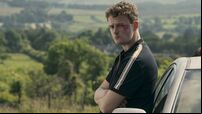'I never noticed that before': Kathriona Devereux s fossil walk in Cork city

The large limestone columns urge you to look to the cross on top of the building or the vaulted ceilings inside.
But last week, a crew of curious people gathered outside of the church, eyes firmly cast downwards, marvelling at the ancient life beneath our feet.
As part of Cork’s Lifelong Learning Festival, I had the pleasure to partake in a Fossil Walk enthusiastically led by UCC’s Professor of Paleontology Maria McNamara.
The sun was sparkling on the river at high tide and provided the perfect illumination for us to ooh and aah at the swirly lines in the Liscannor limestone flagstones outside St Mary’s Church.
These are not pretty patterns by a creative human hand, but are, amazingly, the trace fossils left by burrowing prehistoric creatures called arthropods that lived around 305 million years ago.
Back then, this rock was estuarine muddy material located in a huge delta somewhere south of the equator, and creatures that look a bit like large woodlouses were busy digging through the mud.
The walk was organised by Ireland’s Fossil Heritage, a group of paleontologists who are helping to make connections between this country’s natural landscapes and our mysterious ancient past through school workshops, public events like the Carnival of Science, and fossil walks.
“I never noticed that before”
The wonder continued.
In the impressive limestone church columns, McNamara pointed out the fossils of crinoids - ancient ancestors of sea urchins. This type of limestone is actually called fossiliferous limestone because it contains copious fossils. Once these features are pointed out, we all start spotting and pointing ourselves, astonished that this secret world of fossils was right under our noses all this time.
A veil of fossil ignorance has been lifted!
Onwards we traipsed to the Arc Cinema on North Main Street, clad in jura limestone, from the Jurassic period don’t you know.
Later, we all stared into the blackish limestone gutters of North Main Street, oohing and aahing as, what we thought were just white blemishes (or maybe even a splodge of bird poo) were revealed to be fantastic examples of brachiopods - animals a bit like a sea mussel but 350 million years old.
To look at those familiar white rings (which always reminded me of coffee cup stains) and realise they are evidence of ancient life is kind of profound. And makes the medieval archaeology and history that North Main Street is so famous for feel like mere moments ago by comparison.
“A trip to Lidl will never be the same again”
Humans have long been interested in the hints of creatures and life that appeared in rocks.
Leonardo da Vinci witnessed rocks in the Alps that contained the skeletons of what looked like marine creatures to him, and correctly deduced that it meant the rock must have moved position from its original location in the sea.
This was 300 years before the formal science of palaeontology and geology began putting definite ages on rocks and the ancient remnants of creatures found within them.
At the entrance to Lidl in the Cornmarket Centre, three types of black, red and beige limestone are laid. Da Vinci himself might have been familiar with the rust-coloured Rosso Verona limestone as it can be found in northern Italy. The Romans were fans of it too.
The next time you’re near the Cornmarket Centre, take a moment to pause - put down your bags and scan the floor. You might be standing on a relic of prehistory.
The pièce de résistance of the tour was the final stop outside the new Eason shop on Patrick Street. It’s a fantastically restored building now clad in beautiful Kilkenny marble with an astonishing array of fossils on display.
There are teeny coral fossils the size of a fingertip and there is a giant cross-section of a coral fossil that you can easily envisage growing at the bottom of the sea a couple of hundred million years ago.
For ing onlookers, our fossil appreciating walking group must have been quite the sight - grown adults closely inspecting the wall of a church, cinema, gutters, and now our noses mere millimetres from the surface of bookshop.
But the fossils are truly astonishing and humbling to behold.
If you are interested in having your eyes opened up to the world of fossils, the Irish Fossil Heritage group are holding an event in the Grand Parade library today, Tuesday, April 8. They’re also launching the Great Irish Fossil Hunt, asking the public to start spotting fossils throughout the country.
If you see fossils, take a picture and submit it to the UCC Great Irish Fossil Hunt website.
Later this year, organisers will produce a new fossil map of Ireland - one built by the beady-eyed observations of everyday fossil hunters.







 App?
App?




